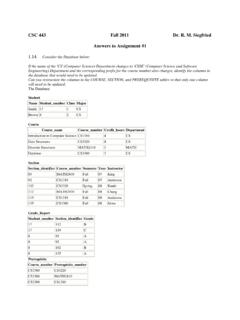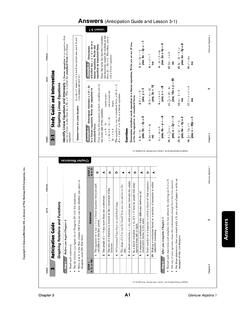Transcription of MA 110 Homework 1 ANSWERS
1 1 9/12/2006 MA 110 Homework 1 ANSWERS This Homework assignment is to be written out, showing all work, with problems numbered and ANSWERS clearly indicated. Put your code number on each page. The assignment is due to be handed in by 8:00 AM, Tuesday, September 12. Late assignments will be penalized, and will not be accepted after the key is posted. Table Table describes an election with four candidates (A, B, C, and D) and the preference schedule: Number of Votes 8 7 6 4 3 1st Choice 4 C 32 A 28 A 24 C 16 B 12 2nd Choice 3 D 24 B 21 D 18 A 12 C 9 3rd Choice 2 A 16 C 14 C 12 B 8 D 6 4th Choice 1 B 8 D 7 B 6 D 4 A 3 1. Using the plurality method, which candidate wins the election in Table If there is a tie for winner, say who are tied. A is winner by plurality with 13 first place votes to C with 12 and B with 3. 2. Using the Borda count method, which candidate wins the election in Table If there is a tie for winner, say who are tied.
2 A: 16 + 28 + 24 + 12 + 3 = 83 B: 8 + 21 + 6 + 8 + 12 = 55 Tie between A and C. C: 32 + 14 + 12 + 16 + 9 = 83 D: 24 + 7 + 18 + 4 + 6 = 59 3. Using the plurality-with-elimination method, which candidate wins the election in Table If there is a tie for winner, say who are tied. Round A B C D 1 13 3 12 0 Eliminate D. 2 13 3 12 Eliminate B. 3 13 15 Winner is C. 4. Using the method of pairwise comparisons, which candidate wins the election in Table If there is a tie for winner, say who are tied. A vs B 25-3 A 1 B vs C 10-18 C 1 C wins with 3 points. A vs C 13-15 C 1 B vs D 14-14 B D A vs D 17-11 D 1 C vs D 22-6 C 1 5. Find the Condorcet candidate in the election in Table , or explain why there is not one. C won all three of her one-to-one comparisons, so is a Condorcet candidate. 6. If in any ANSWERS to questions 1-4 you did find a tie for winner, use bottom-up comparison to break the tie. A and C tied under Borda count. C has 0 last place votes and A has 3, so C wins the tiebreaker.
3 7. If in any ANSWERS to questions 1-4 you did find a tie for winner, use top-down comparison to break the tie. A and C tied under Borda count. A has 13 first place votes and C has 12, so A wins the tiebreaker. 8. Rank the candidates in the election in Table using the extended Borda count method. (Do not break ties, but state ranks with ties.) First A and C tie; third D; fourth B. [Accept: First A and C tie; second D; third B.] 2 9/12/2006 9. Rank the candidates in the election in Table using the extended plurality-with-elimination method. (Do not break ties, but state ranks with ties.) Use reverse order of elimination. The ranking is thus: First C; second A; third B; fourth D. 10. An election is to be decided using the plurality method. There are five candidates and 212 votes. What is the smallest number of votes that a winning candidate can have if there are to be no ties for winner? 44 + 42 + 42 + 42 + 42 = 212. The smallest winning plurality number is 44.
4 11. An election is held among four candidates A, B, C, and D using the Borda count method. There are 24 voters. If candidate A received 55 points, candidate B received 71 points, and candidate C received 46 points, how many points did candidate D receive? Who won the election? There are 10 points/ballot x 24 ballots = 240 Borda points at stake. Together A, B, and C got 55 + 71 + 46 = 172 points leaving 240 172 = 68 for D. B won. 12. An election with five candidates A, B, C, D, and E is held using the method of pairwise comparisons. Partial results of the pairwise comparisons are as follows: E wins 2 pairwise comparisons; C wins 2 and ties 1; A and B each win 1 and tie 1. How many pairwise comparisons did D win. Who wins the election? There are 4 + 3 + 2 + 1 = 10 comparison points at stake. Together E, C, A, and B got 2 + + + = leaving 10 = for D. It is a tie between C and D. 13. Write out a statement of each of the four fairness criteria.
5 See text or notes. 14. Give an example of an election (not from the book) decided by Borda count which violates the majority criterion. [Hint: it can be done with a preference schedule with three candidates and two columns. Easy.] Number of votes 4 3 1st Choice A B 2nd Choice B C 3rd Choice C A 15. Give an example of an election (not from the book) decided by Borda count which violates the Condorcet criterion, but which does not violate the majority criterion. [Hint: it can be done with a preference schedule with four candidates and three columns. Harder.] Number of Votes 5 4 1 1 1st Choice D A B C 2nd Choice B B D D 3rd Choice A C C A 4th Choice C D A B (Also, see example below in Table ) Table Table describes an election with five candidates (A, B, C, D, and E) and the preference schedule: Number of Votes 9 6 4 1st Choice 5 B 45 D 30 C 20 2nd Choice 4 E 36 C 24 B 16 A has 15 Borda points, B has 17, and C has 10. So B wins by Borda count.
6 But A has a majority of first place votes. This violates the Majority Criterion. B has 32 Borda points to D 30, A 29, and C 19, so B wins by Borda count. But D wins all her one-to-one comparisons, so is a Condorcet candidate. No candidate has a majority (6) of 1st place votes. Hence, the Condorcet Criterion, but not the Majority Criterion, is violated. 3 9/12/2006 3rd Choice 3 A 27 A 18 E 12 4th Choice 2 C 18 B 12 D 8 5th choice 1 D 9 E 6 A 4 16. Determine the winner of the election in Table by each of the methods: Borda count, plurality-with-elimination, and pairwise comparisons. 17. The election in Table is declared void. Disgusted with the initial outcome of the election, candidate D drops out. The voters vote again, with exactly the same preferences as in Table , but without candidate D in the race. Determine the winner of the election by each of the same three voting methods again. The new preference schedule is as follows: Number of Votes 9 6 4 1st Choice 4 B 36 C 24 C 16 2nd Choice 3 E 27 A 18 B 12 3rd Choice 2 A 18 B 12 E 8 4th Choice 1 C 9 E 6 A 4 18.
7 Based solely upon the information in the ANSWERS to questions 16 and 17 which fairness criteria (if any) are violated in this election by each election method used? There are five violations of fairness criteria evident. a. In the original election, C is a Condorcet candidate, but B wins by Borda count. This shows Borda count violates the Condorcet Criterion. b. In the original election, C is a Condorcet candidate, but B wins by plurality-with-elimination. This shows plurality-with-elimination violates the Condorcet Criterion. Borda: A: 27 + 18 + 4 = 49 B: 45 + 12 + 16 = 73 C: 18 + 24 + 20 = 62 D: 9 + 30 + 8 = 47 E: 36 + 6 + 12 = 54 The winner is B. Plurality with Elimination: Round A B C D E 1 0 9 4 6 0 Eliminate A and E. 2 9 4 6 Eliminate C. 3 13 6 B wins. Pairwise Comparisons: A vs B 6-13 B 1 B vs D 13-6 B 1 C wins with 4 points. A vs C 9-10 C 1 B vs E 19-0 B 1 (In fact, C is a Condorcet candidate.) A vs D 9-10 D 1 C vs D 13-6 C 1 A vs E 6-13 E 1 C vs E 10-9 C 1 B vs C 9-10 C 1 D vs E 6-13 E 1 Borda: A: 18 + 18 + 4 = 40 B: 36 + 12 + 12 = 60 C: 9 + 24 + 16 = 49 E: 27 + 6 + 8 = 41 The winner is B.
8 Plurality with Elimination: Round A B C E 1 0 9 10 0 C wins by majority. Pairwise Comparisons: Since C has a majority of first place votes, C will win all of her pairwise comparisons, so is a Condorcet candidate. Hence, C will win by the method of pairwise comparison, since no one can have as many points as she. 4 9/12/2006 c. From election to re-election, when D dropped out, the plurality-with-elimination winner changed from B to C. Thus, plurality-with-elimination violates the Independence of Irrelevant Alternatives Criterion. d. The re-election is an example of a violation of the Majority Criterion by Borda count. Candidate C has a majority of first place votes, but B wins by Borda count. e. The re-election is also an example of a violation of the Condorcet Criterion, since C is a Condorcet candidate, but B wins by Borda count. 19. Refer to the weighted voting system [q: 8, 3, 2, 1, 1]. For each value of q that is reasonable, list which player is a dictator (if any), which players (if any) have veto power (a dictator automatically has veto power), and which players are dummies (if any).
9 [15: 8, 3, 2, 1, 1] Every player has veto power; no dictator; no dummies. [14: 8, 3, 2, 1, 1] Players 1, 2, and 3 have veto power; no dictator; no dummies. [13: 8, 3, 2, 1, 1] Players 1 and 2 have veto power; no dictator; no dummies. [12: 8, 3, 2, 1, 1] Player 1 has veto power; no dictator; no dummies. [11: 8, 3, 2, 1, 1] Player 1 has veto power; no dictator; no dummies. [10: 8, 3, 2, 1, 1] Player 1 has veto power; no dictator; no dummies. [9: 8, 3, 2, 1, 1] Player 1 has veto power; no dictator; no dummies. [8: 8, 3, 2, 1, 1] Player 1 is a dictator, so has veto power, too; all others are dummies. 20. Refer to the weighted voting system [8: m, 4, 2, 1]. For each value of m that is reasonable, up to the point where player 1 is a dictator, list which players (if any) have veto power (but are not dictator), and which players are dummies (if any). [8: 1, 4, 2, 1] Every player has veto power; there are no dummies. [8: 2, 4, 2, 1] Players 1, 2, and 3 have veto power; no dictator; player 4 is a dummy.
10 [8: 3, 4, 2, 1] Players 1 and 2 have veto power; no dictator; no dummies. [8: 4, 4, 2, 1] Players 1 and 2 have veto power; no dictator; players 3 and 4 are dummies. [8: 5, 4, 2, 1] Player 1 has veto power; no dictator; no dummies. [8: 6, 4, 2, 1] Player 1 has veto power; no dictator; player 4 is a dummy. [8: 7, 4, 2, 1] Player 1 has veto power; no dictator; no dummies. [8: 8, 4, 2, 1] Player 1 is now a dictator and the rest are dummies. 21. Give an example of a weighted voting system with five players, no dictator, exactly two players with veto power, and no dummies. Many examples are possible. One is [7: 3, 3, 1, 1, 1]. 22. Give an example of a weighted voting system with four players, in which players one and two each have twice as many votes as each of the other players, there are no dummies, and for which 2/3 of the votes is required to pass a motion. Many examples are possible. One is [6: 2, 2, 1, 1]. 23. Find the Banzhaf power distribution of the weighted voting system [7: 3, 2, 2, 2].










